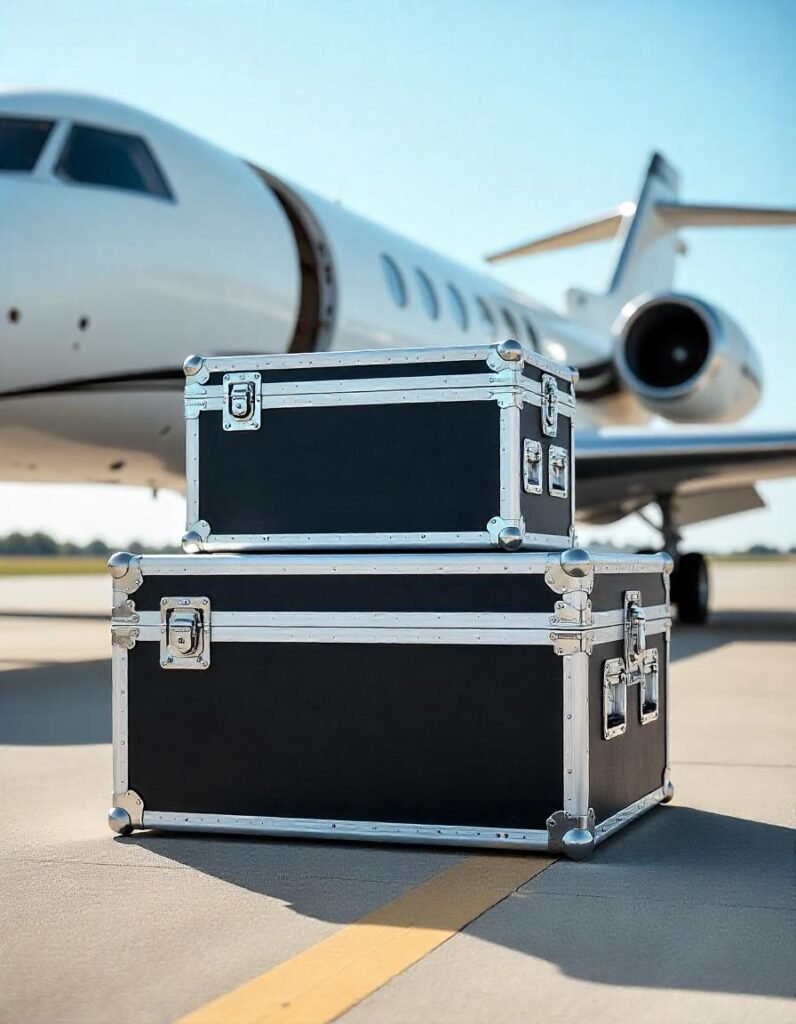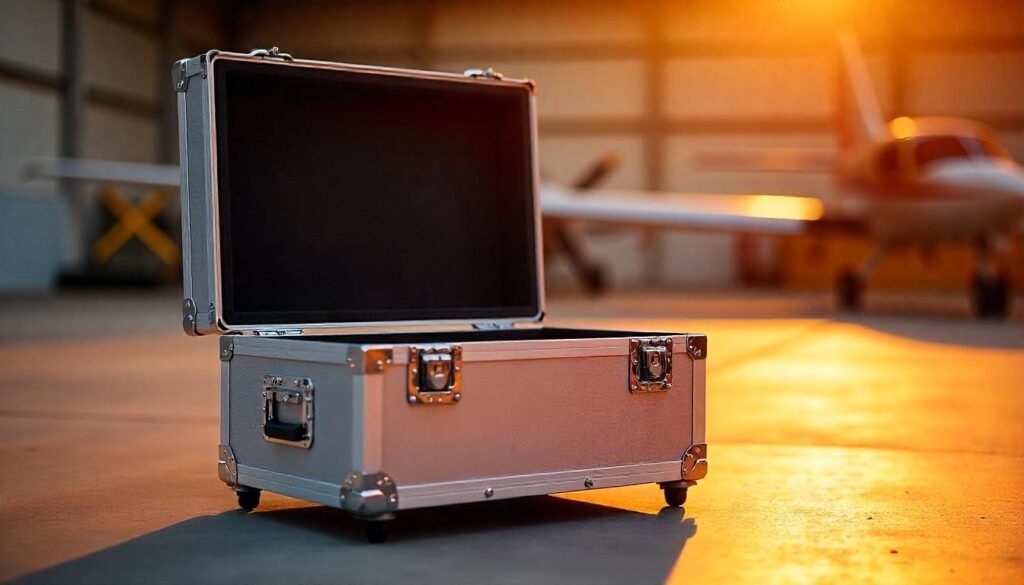The aviation and aerospace Dominus are precision-oriented industries with utmost concern for safety and reliability. Components ranging from avionics to bulk heavy aircraft parts are subjected to standards of protection from contingency damages during transport and storage. This is where flight cases for aviation come in. They are specialized containers that give an extra edge of protection to sensitive equipment at their points of travel through transport between airports or even when kept for usage at a later time.
This blog will explore the fundamental importance that flight cases have in the aerospace and aviation industries. However, it will also highlight the use of aerospace equipment cases, protection for parts of aircraft, and the use of aviation transport cases against all important equipment. Finally, by the end of this article, we will also go into some emerging trends and technologies that will change how these cases go about evolving in and beyond 2025.
What Are Flight Cases?
Flight cases are rugged, heavy-duty containers that are used to protect sensitive equipment and components from damage during storage, shipping, and handling. They were originally created for use in the aerospace industry, and their name is derived from their application to hold sensitive equipment on aircraft. Built to endure the turbulence of air travel-high impact force, vibration, temperature change, and humidity-these cases are extensively employed in the aviation field.
The aerospace and aviation industries will design custom flight cases for aviation, tailored to the specific tools, instruments, or parts of aircraft being protected in transit.
Key Benefits of Flight Cases in Aerospace and Aviation
1. Protection from Impact and Vibration
Aviation experts work with sensitive equipment like avionics, instruments, and sensors, all of which are susceptible to damage due to impacts or vibrations. Aerospace equipment cases are made with foam padding and shock-absorbing materials to shield against such forces. These cases help ensure delicate equipment can withstand, and still work, after a high impact, whether during transport or on-site handling.
2. Temperature and Environmental Protection
All aircraft components and some aerospace equipment get affected by environmental conditions, such as temperature and humidness. For example, avionics get damaged or tend to malfunction due to moisture content or extreme heat. Protective cases for aircraft parts insulate the equipment from temperature variations and environmental damage. Instead, these cases can modify their internal environment for optimum storage conditions, thereby ensuring peace of mind for the owners during such times as transportation or storage.

3. Organized Storage and Easy Access
Access to the essential parts or tools quickly becomes critical in a fast-paced aviation environment. By organizing equipment, spare parts, and maintenance tools into cases, much easier searching is for the technician. The inner compartments are typically custom-made to be able to store specific items, ensuring everything will be safe and available once required.
4. Durability and Longevity
Flight cases in the aerospace and aviation industries are made so with a mind that they are likely to take a battering. Heavy-duty flight cases being constructed from aluminum, plywood, or composite boards are never made to fail proprietary use or rough handling under an air travel context-best suited for doing plywood, though-it stands as one of the phenomenal materials for flight-casing duties. Besides, this material has excellent resilience against bruises and mishandling in transporting cases. It also resists changes in temperature and environment. They are designed to withstand severe stresses, making sure they keep getting dependable for years and thus save on maintenance costs while giving you value over the long term.
5. Compliance with Industry Standards
The different flight cases are tested and produced according to industry standards when it comes to the ideal weight limit as well as the other requirements in centimeters. Otherwise, it is one of the several industry standards or regulations that apply to these cases-for example, fire safety test requirements and maximum weight regulations-these cases are manufactured to be above all of these criteria and live up to them. Use of aircraft maintenance cases compliant with such regulations will guarantee the safe storage of items inside them as mandated in the requirements for your industry.
Types of Flight Cases Used in Aerospace and Aviation

The aviation world has many kinds of flight cases, mainly created for different needs in the industry. Some of the most common types are:
1. Aerospace Equipment Cases
Cases for aerospace equipment are really meant to protect all the avionics, communication pieces, navigation systems, and sensors. Aerospace equipment cases are usually designed with various custom foam interiors to snugly fit every piece of equipment so that they are not damaged during transport and that they are at less risk of malfunction.
2. Protective Cases for Aircraft Parts
Parts such as engines and turbines undercarriage and other large components should have their own cases to protect them while in transport. Protective cases for aircraft parts assure that these highly expensive and highly delicate parts reach their destination intact under rough handling and very extreme conditions during the entire shipping chain.
3. Aviation Transport Cases
Transport cases meant for aviation are those used to ferry tools, maintenance equipment and spare parts to and from maintenance facilities or airports. These types of cases qualify as lightweight yet durable. Everything about such cases has to be safe and secure as well as easier in transportation.
4. Heavy-Duty Flight Cases
Heavy-duty flight cases can be used for larger, more fragile objects such as radar sets or large avionics systems. These types of cases are built with the biggest rough material like reinforced plywood, aluminum, or impact-and shock-resistant plastics for the max protection. Plywood is especially good for heavy-duty cases as it is combining strength and impact resistance, giving strength without too much weight.
5. Aircraft Maintenance Cases
Aircraft maintenance cases are used for storing important tools and spare parts by maintenance teams. These cases are organized for easy transportation, facilitating easy access to the right equipment by technicians for repair and routine aircraft maintenance checks.
The Future of Flight Cases in Aerospace and Aviation (2025 and Beyond)
As aerospace and all aviation sectors are developing, the demand for more high-end specialized equipment protection solutions has increased. From 2025 and onwards, there will be considerable developments in aviation flight cases-such as smart technology integration into cases, eco-friendly materials, and customization features. These will maximize the transport and protection of aerospace equipment, but keep efficiency and safety dutifully into consideration.
1. Integration of Smart Technology
Equipment cases and aviation transport cases having smart technology features like sensors, GPS tracking, and RFID tags will make them monitor equipment conditions in real-time for future aviation professionals. Thus, aviation professionals will be able to monitor the location as well as condition of their equipment and receive notifications if any of their factors, e.g., humidity, level of shock go beyond safe limits.
2. Sustainable Materials and Eco-friendly Design
There would be much talk of sustainability, which would prompt flight cases like these being fabricated using recycled plastic, biodegradable foam, and more eco-friendly materials. These hard-wearing flight cases would be rough edged and purely green design with waste minimization to help in the aviation sector’s lift-off reduction environmental footprint.
3. Customization and Modular Designs
In the future, aircraft maintenance cases will become more tailored, having modular interiors that can be modified according to the equipment in them. This will allow for more effective storage and transportation of parts and tools so that technicians can easily access the equipment they need.
4. Lightweight Construction for Efficiency
Due to the requirement of minimizing fuel expenses and maximizing operational efficiency, flight cases will become lighter. Lighter flight cases will be made using advanced composite materials for strengthening and reducing the weight of the equipment, making it lighter and easier to transport.
5. Enhanced Security Features
Flight cases will most probably include more sophisticated security features, including biometric locks, tamper-proof seals, and advanced locking mechanisms, to provide protection for sensitive equipment. High-value items, like avionics and critical aircraft parts, will require enhanced security.
Conclusion
Flight cases have now been widely adopted within the aerospace and aviation sectors for safekeeping equipment, tools, and parts during transport, storage, and manipulation. They contain precious items that are mostly subjected to accidents due to impact, vibrations, and environmental conditions as well as support in operational efficiency by making essential components accessible.
Looking ahead to the year of 2025, further advances in technology, new materials, and more extensive customization options are going to call forth great changes in flight-case design-that will make it even more intelligent, safer, and more efficient-carrying aviation and aerospace industries always in the front ranks of safety, efficiency, and innovation.
In effect, they would inherit the benefits regarding protection, which only high-quality travel cases could offer. This would stand true for years into the future, so they could adequately prepare for any future challenges of aerospace and aviation.

